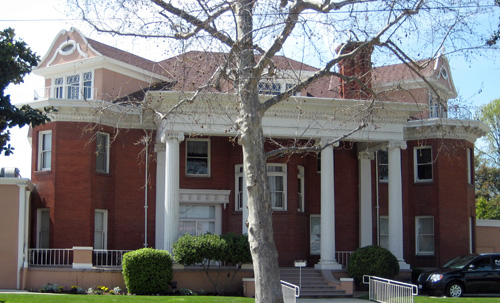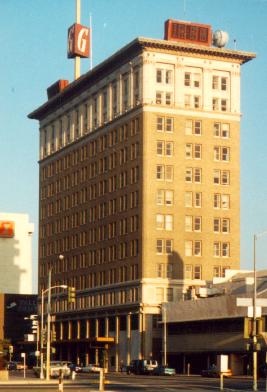Eugene Mathewson (1867-1959)
Eugene Mathewson was born in Webster, Massachusetts, on November 6, 1867. He trained in the construction business in Massachusetts before becoming a licensed architect, and practiced there before moving to California in the early 1890s. Settling in San Francisco, Mathewson associated with prominent architect Frederick H. Meyer. By 1900 Meyer had sent Mathewson permanently to Fresno as his local agent. Mathewson's first project in the Valley was a residence for Frank Wilson in Dinuba. The 33-year-old architect bicycled to Dinuba once a week to monitor construction of the home. Among the Fresno projects he supervised during his early tenure in the Central Valley were the O. J. Woodward Home (1901), the United Presbyterian Church (1901), and the Fresno Republican Building (1902-03).
 In early 1903, Mathewson opened his own office,
having secured commissions for a country mansion for Fred Dow, the Porteous
Building, and the $50,000 First National Bank. A string of high-profile
projects followed, notably the F. W. Osborn Residence (1904), the
Graff Residence (1904), and the Prescott Mansion
(1905, on right). Of the three residences, the Osborn home, built as a
fire-proof dwelling for a prominent local road builder, was the most advanced
and sophisticated in its construction and the most ambitious in its raw bulk
and idiosyncratic architectural ornamentation. It established Mathewson as a
force to be reckoned with as the community embraced a passion to discover its
architectural identity. For Mathewson, major early success came when he secured
the contract in 1905 to design the new Fresno City Hall. With this commission
his career was assured. His knowledge of period styles and his increasingly
professional notoriety earned him a large clientele. His high-profile works
displayed a thorough grasp of Beaux-arts design traditions and the goals of the
City Beautiful Movement at the turn of the century. Yet he was equally
comfortable working in the more humble Craftsman styles that were growing in
popularity at that time. Eugene Mathewson was also a colorful personality.
Known for his eccentricities and public bravado, he cut a dashing figure,
speeding about town from construction site to construction site in his 50-
horsepower National roadster, accompanied by his prize-winning Boston bull
terrier, "Thunder."
In early 1903, Mathewson opened his own office,
having secured commissions for a country mansion for Fred Dow, the Porteous
Building, and the $50,000 First National Bank. A string of high-profile
projects followed, notably the F. W. Osborn Residence (1904), the
Graff Residence (1904), and the Prescott Mansion
(1905, on right). Of the three residences, the Osborn home, built as a
fire-proof dwelling for a prominent local road builder, was the most advanced
and sophisticated in its construction and the most ambitious in its raw bulk
and idiosyncratic architectural ornamentation. It established Mathewson as a
force to be reckoned with as the community embraced a passion to discover its
architectural identity. For Mathewson, major early success came when he secured
the contract in 1905 to design the new Fresno City Hall. With this commission
his career was assured. His knowledge of period styles and his increasingly
professional notoriety earned him a large clientele. His high-profile works
displayed a thorough grasp of Beaux-arts design traditions and the goals of the
City Beautiful Movement at the turn of the century. Yet he was equally
comfortable working in the more humble Craftsman styles that were growing in
popularity at that time. Eugene Mathewson was also a colorful personality.
Known for his eccentricities and public bravado, he cut a dashing figure,
speeding about town from construction site to construction site in his 50-
horsepower National roadster, accompanied by his prize-winning Boston bull
terrier, "Thunder."
 For the next two
decades, Mathewson was at the center of building activity in the Central San
Joaquin Valley. His mastery of building types ranged from his 1910 Craftsman
bungalow for B. J. Stoner near Centerville to his 1917 reinforced concrete
Mason Building, one of the first structures to
alter dramatically Fresno's skyline. When commissioned to design the Mattei
Building in 1920 (on left) and the Brix Office Building in 1922, Mathewson
traveled to New York to consult with architect Robert Von Ezdorf. Von Ezdorf, a
chief designer for the prestigious firm of Cross & Cross and a specialist
in high- rise office buildings, joint-ventured these projects with Mathewson,
bringing the latest in East Coast architectural technology and design theory to
Fresno. Mathewson thus became a vocal proponent of high-rise structures in
Fresno during the mature years of his career, challenging those Fresno
residents who fought to keep the city from growing skyward.
For the next two
decades, Mathewson was at the center of building activity in the Central San
Joaquin Valley. His mastery of building types ranged from his 1910 Craftsman
bungalow for B. J. Stoner near Centerville to his 1917 reinforced concrete
Mason Building, one of the first structures to
alter dramatically Fresno's skyline. When commissioned to design the Mattei
Building in 1920 (on left) and the Brix Office Building in 1922, Mathewson
traveled to New York to consult with architect Robert Von Ezdorf. Von Ezdorf, a
chief designer for the prestigious firm of Cross & Cross and a specialist
in high- rise office buildings, joint-ventured these projects with Mathewson,
bringing the latest in East Coast architectural technology and design theory to
Fresno. Mathewson thus became a vocal proponent of high-rise structures in
Fresno during the mature years of his career, challenging those Fresno
residents who fought to keep the city from growing skyward.
Eugene Mathewson, a sportsman all his life, gave up the practice of architecture in 1928 to live in Arcata, California, and spent his retirement years fishing. He died on January 20, 1959.
©1996 John Edward Powell. All rights reserved.